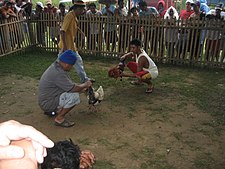Cockfight
This articleneeds additional citations forverification.(May 2024) |


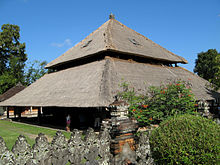
Cockfightingis ablood sportinvolving domesticatedroostersas the combatants. The first documented use of the wordgamecock,denoting use of the cock as to a "game",asport,pastimeorentertainment,was recorded in 1634,[1]after the term "cock of the game"used by George Wilson, in the earliest known book on the sport of cockfighting inThe Commendation of Cocks and Cock Fightingin 1607. But it was duringMagellan'svoyage of discoveryof thePhilippinesin 1521 when modern cockfighting was first witnessed and documented for Westerners by the ItalianAntonio Pigafetta,Magellan's chronicler, in the Kingdom ofTaytay.
The gamecocks (not to be confused withgame birds), are speciallybredand conditioned for increased stamina and strength. Male and femalechickensof such abreedare referred to asgamefowl.[citation needed]Cocks possess congenitalaggressiontoward all males of the samespecies.[clarification needed][citation needed]Wagers are often made on the outcome of the match, held in a ring called acockpit.
Cockfighting is a blood sport due in some part to thephysical traumathe cocks inflict on each other, which is sometimes increased by attaching metal spurs to the cocks'natural spurs.While not all fights are to the death, the cocks may endure significant physical trauma. In some areas around the world, cockfighting is still practiced as a mainstream event; in some countries it is regulated by law, or forbidden outright.[2][3]
Process[edit]
Two owners place their gamecock in the cockpit. The cocks fight until one of them dies or is critically injured. Historically, this was in acockpit,a term which was also used in the 16th century to mean a place ofentertainmentor frenzied activity.William Shakespeareused the term inHenry Vto specifically mean the area around the stage of atheatre.In Tudor times, thePalace of Westminsterhad a permanent cockpit, called theCockpit-in-Court.
History[edit]


Cockfighting is an ancient spectator sport. There is evidence that cockfighting was a pastime in theIndus Valley civilization.[4]The Encyclopædia Britannica (2008) holds:[5]
The sport was popular in ancient times in India, China, Persia, and other Eastern countries and was introduced into Ancient Greece in the time of Themistocles (c. 524–460 BC). For a long time the Romans affected to despise this "Greek diversion", but they ended up adopting it so enthusiastically that the agricultural writer Columella (1st century AD) complained that its devotees often spent their whole patrimony in betting at the side of the pit.
Based on his analysis of a Mohenjo-daro seal,[6]Iravatham Mahadevan speculates that the city's ancient name could have been Kukkutarma ( "the city [-rma] of the cockerel [kukkuta]" ).[7][8]However, according to a recent study,[9]"it is not known whether these birds made much contribution to the modern domestic fowl. Chickens from theHarappanculture of theIndus Valley(2500–2100 BC) may have been the main source of diffusion throughout the world. "Also," Within the Indus Valley, indications are that chickens were used for sport and not for food (Zeuner 1963) ", cited in R.D. Crawford (1990). and that by 1000 BC they had assumed" religious significance ".[8]
In China, the first recorded cockfight took place in 517 BC.[10][11]
Some additional insight into the pre-history of European and American secular cockfighting may be taken fromThe London Encyclopaedia:
At first cockfighting was partly a religious and partly a political institution at Athens; and was continued for improving the seeds of valor in the minds of their youth, but was afterwards perverted both there and in the other parts of Greece to a common pastime, without any political or religious intention.[12]
An early image of a fighting rooster has been found on a 6th-century BCseal of Jaazaniahfrom the biblical city ofMizpah in Benjamin,nearJerusalem.[13][14]Remains of these birds have been found at other Israelite Iron Age sites, when theroosterwas used as a fighting bird; they are also pictured on other seals from the period as a symbol of ferocity, such as the late-7th-century BC red jasper seal inscribed "Jehoahaz, son of the king",[15][16]which likely belonged toJehoahaz of Judah"while he was still a prince during his father's life".[17]
The anthropologistClifford Geertzwrote the influential essayDeep Play: Notes on the Balinese Cockfight,on the meaning of the cockfight in Balinese culture.

Regional variations[edit]

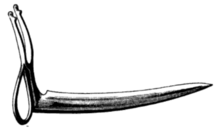

In some regional variations, the birds are equipped with either metal spurs (calledgaffs) or knives, tied to the leg in the area where the bird's natural spur has been partially removed. Acockspuris a bracelet (often made of leather) with a curved, sharp spike which is attached to the leg of the bird. The spikes typically range in length from "short spurs" of just over an inch to "long spurs" almost two and a half inches long. In the highest levels of 17th century English cockfighting, the spikes were made of silver. The sharp spurs have been known to injure or even kill the bird handlers.[19]In thenaked heelvariation, the bird's natural spurs are left intact and sharpened: fighting is done without gaffs or taping, particularly in India (especially inTamil Nadu). There it is mostly fought naked heel and either three rounds of twenty minutes with a gap of again twenty minutes or four rounds of fifteen minutes each and a gap of fifteen minutes between them.[20]
Cockfighting is common throughoutSoutheast Asia,where it is implicated in spreadingbird flu.[21][22]Cockfighting is a popular form of fertilityworshipinSoutheast Asia.[23]
India[edit]
The sport of cockfighting has long been outlawed in India, with the Supreme Court proclaiming the practice to be in direct violation of the Prevention of Cruelty to Animals Act 1960.[24]According to M Ravindranath Babu Superintendent, Indian Police, it is also considered a hijack of traditional festivals to promote illegal betting and gambling. Despite this, institutional resistance to government bans on cockfighting occurs. At India's ‘Sun God’ festival in 2012, the local Bharatiya Janata Party district committee campaigned for the right to have cock-fights. This was then agreed by local police if it took place inside the temples.[24]
Cockfights are currently common in the southern Indian states of Telangana, Andhra Pradesh, Tamil Nadu and Karnataka despite a countrywide ban imposed in 1960. It is a regional spectacle primarily taking place in January, coinciding with harvest festival celebrations. LikeJallikattu,Cock fighting (Seval Sandai) an ancient spectator sport is mentioned in Sangam literaturePaṭṭiṉappālaiandTirumurukāṟṟuppaṭai.[citation needed]
Indonesia[edit]
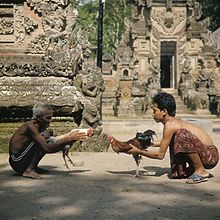
Cockfighting is a very oldtraditioninBalinese Hinduism,the Batur Bang Inscriptions I (from the year 933) and the Batuan Inscription (dated 944 on the Balinese Caka calendar) disclose that thetabuh rahritual has existed for centuries.[25]
InBali,cockfights, known astajen orsabung ayam,are practiced in an ancient religious purificationritualto expel evil spirits.[26]This ritual, a form ofanimal sacrifice,is calledtabuh rah( "pouring blood" ).[27]The purpose of tabuh rah is to provide an offering (the blood of the losing chicken) to the evil spirits. Cockfighting is a religious obligation at every Balinese temple festival or religious ceremony.[28]Cockfights without a religious purpose are consideredgamblingin Indonesia, although it is still largely practiced in many parts of Indonesia. Women are generally not involved in the tabuh rah process. The tabuh rah process is held on the largest pavilion in a Balinese temple complex, thewantilan.
The American anthropologistClifford Geertzpublished his most famous work,Notes on the Balinese Cockfight,on the practice of cockfights in Bali. In it, he argued that the cockfight served as a pastiche or model of wider Balinese society from which judgments about other aspects of the culture could be drawn.
Philippines[edit]

Cockfighting was already flourishing in pre-colonial Philippines, as recorded byAntonio Pigafetta,the Italian diarist aboardFerdinand Magellan's 1521 expedition.[29]
Cockfighting, locally termedsabong,remains a popular pastime in thePhilippines,where both illegal and legal cockfights occur. Legal cockfights are held in cockpits every week, whilst illegal ones, calledtupadaortigbakay,[30]are held in secluded cockpits where authorities cannot raid them. In both types, knives orgaffsare used. There are two kinds of knives used in Philippine cockfighting: single-edged blades (used in derbies) and double-edged blades; lengths of knives also vary. All knives are attached on the left leg of the bird, but depending on agreement between owners, blades can be attached on the right or even on both legs.Sabong[31]and illegaltupada,are judged by a referee calledsentensyadororkoyme,whose verdict is final and not subject to any appeal.[32]Bets are usually taken by thekristo,so named because of his outstretched hands when calling out wagers from the audience from memory.
The country has hosted severalWorld Slasher Cupderbies, held biannually at theSmart Araneta Coliseum,Quezon City,where the world's leading game fowl breeders gather. World Slasher Cup is also known as the "Olympics of Cockfighting". TheWorld Gamefowl Expo 2014was held in the World Trade CenterMetro Manila.
Other bird species[edit]
Malesaffron finches[33]andcanarieshave been used in fights on occasion.[34]
Legal status[edit]

Argentina[edit]
Article 3.8 of Law 14.346 on the Ill-Treatment and Acts of Cruelty to Animals of 1954 explicitly prohibits 'carrying out public or private acts of animal fights, fights of bulls and heifers, or parodies [thereof], in which animals are killed, wounded or harassed.'[35]
Australia[edit]
Cockfighting, and the possession of cockfighting equipment, is illegal in Australia and punishable with prison time.[36][37]
Belgium[edit]
In Belgium, cockfights have been prohibited since 1867. In 1929 all organised fights between animals were banned. In 1986 and 1991, the animal welfare act was amended by also criminalising attendance of cockfights. Offenders risk six months imprisonment and a fine of 2,000 euros. Since the 1990s, several people have been prosecuted for cockfighting.[38]
Brazil[edit]
Cockfighting (rinha de galos) was banned in 1934 with the help of PresidentGetúlio Vargasthrough Brazil's 1934 constitution, passed on 16 July. Based on the recognition of animal rights in the Constitution, a Brazilian Supreme Court ruling resulted in the ban of animal related activities that involve claimed "animal suffering such as cockfighting, and a tradition practiced in southern Brazil, known as 'Farra do Boi' (the Oxen Festival)",[39]stating that "animals also have the right to legal protection against mistreatment and suffering".[40]
Canada[edit]
Canada's Criminal Code includes animal cruelty legislation, which criminalize any kind of fighting or baiting of any animal.[41]These laws have been amended and made more restrictive over time, and as of 2018 include bans on fighting, promoting, arranging and profiting from fights, as well as breeding, training and transporting of animals for the purpose of fights and keeping of arenas for the purpose of animal fights, for animals of any kind.[42]
Chile[edit]
Chilean Law no. 20.380 on Animal Protection of 25 August 2009 explicitly exempts various forms of 'animal sports' in Article 16: 'The norms of this law will not apply to sports in which animals participate, such as rodeo, cowfights, movement to the rein and equestrian sports, which will be governed by their respective regulations.'[43]
Colombia[edit]
In Colombia, cockfighting is a tradition, especially in the Caribbean region and in some areas of the Andean interior. Cockfights are held during theFestival de la Leyenda VallenatainValledupar.In August 2010, the Constitutional Court of Colombia rejected a lawsuit that sought to prohibitbullfighting,corralejasand cockfighting with the argument that they constituteanimal abuse.In March 2019, the same court confirmed such rule, under the argument that cockfighting and bullfighting are traditions with cultural roots in some municipalities of the country.[44]TheAsociación Nacional de Criadores de Gallos de Peleaorganizes an international cockfighting championship.[45]
Cockfighting was immortalized in the novelOne Hundred Years of Solitudeby Gabriel García Márquez, in episodes such as the events that led to the death of Prudencio Aguilar, or the fondness for it by José Arcadio Segundo.[46]Cockfighting was one of the main subjects ofLa caponera,a TV adaptation ofJuan Rulfo's novel,El gallo de oro,aired in Colombia and other countries in the region during the late 90s.
Costa Rica[edit]
Cockfights have been illegal in Costa Rica since 1922.[47]The government deems the activity as animal cruelty, public disorder and a risk for public health and is routinely repressed by the State's National Secretary for Animal Welfare.[48]The activity is also rejected by most of the population, as 88% of Costa Ricans dislike cockfights according to recent polls of theNational University.[49]Since 2017, the activity is punishable with up to two years of prison.[50]
Cuba[edit]
In Cuba, cockfighting is legal and popular, although gambling on matches has been banned since the1959 Revolution.[51][52]The state has opened official arenas, locally known as "galleras", including a 1,000-seat venue inCiego de Ávila,but there are also banned underground cockfighting pits.[52]
Cockfighting was so common following the Spanish conquest in the early 16th century that there were arenas in every urban and rural town. The first official known document about cockfighting in Cuba dates from 1737. It is a royal decree asking, to the governor of the island, a report about the inconveniences that might cause cockfights "with the people from land and sea" and asking for information about rentals of the games. The SpaniardMiguel Tacón,Lieutenant General and governor of the colony, banned cockfighting by a decree dated on October 20, 1835, limiting these spectacles only to holidays.[citation needed]
In 1844, a decree dictated by the Captain General of the island,Leopoldo O'Donnell,forbade to non-white people the attendance to these shows. During the second half of the 19th century, many authorizations were conceded for building arenas, until GeneralJuan Rius Rivera,then civilian governor in Havana, prohibited cockfighting by a decree of October 31, 1899, and later the Cuban governor, GeneralLeonard Wood,dictated the military order no. 165 prohibiting cockfights in the whole country since June 1, 1900.[53]
In the first half of the 20th century, legality of cockfights suffered several ups and downs.[54]
In 1909, the then-Cuban presidentJosé Miguel Gómez,with the intention to gain followers, allowed cockfights once again, and then regulations were agreed for the fights.[55]
Up to the beginning of 1968, cockfights used to be held everywhere in the country, but with the purpose of stopping the bets, the arenas were closed and the fights forbidden by the authorities. In 1980, authorities legalized cockfights again and a state business organization was created with the participation of the private breeders, grouped in territories. Every year the state organization announces several national tournaments from January to April, makes trade shows and sells fighting cocks to clients from other Caribbean countries.[53]
Dominican Republic[edit]

In the Dominican Republic, cockfighting is legal, but according toDominican Today'increasingly rejected by society' as of December 2018.[56]There is at least one arena (gallera)in every town, whereas in bigger cities largercoliseoscan be found. Important fights are broadcast on television and newspapers have dedicated pages to cockfights and the differenttrabas,the local name for gamefowl breeding grounds. Those dedicated to the breeding and training of fighting cocks are calledgallerosortraberos.The cocks are often outfitted with special spurs made from various materials (ranging from plastic to metal or evencareyshell) and fights are typically to the death. Public perception of the sport is as normal as that of baseball or any other major sport.[citation needed]
France[edit]
Holding cockfights is a crime in France, but there is an exemption under subparagraph 3 of article 521–1 of theFrench penal codefor cockfights and bullfights in locales where an uninterrupted tradition exists for them. Thus, cockfighting is allowed in theNord-Pas de Calaisregion, where it takes place in a small number of towns includingRaimbeaucourt,La Bistade[57]and other villages aroundLille.[58]However, the construction of new cockfighting areas is prohibited, a law upheld by theConstitutional Council of Francein 2015.[59]
Cockfighting is also legal in someFrench Overseas Territories.[59]
Germany[edit]
Cockfights have no tradition in Germany. They are illegal under increasingly stringent criminal law since 1871.[60][61][62]
Haiti[edit]
Cockfighting is legal in Haiti. Nevins (2015) described it as 'the closest thing to a national sport in Haiti', being organised every Sunday morning in places across the country. Sharp spurs are attached to the roosters' feet to make them extra lethal, and the fight usually ends with the death of one of the animals.[63]
Honduras[edit]
In Honduras, under Article 11 of 'Decree no. 115-2015 ─ Animal Protection and Welfare Act' that went into effect in 2016, dog and cat fights and duck races are prohibited, while 'bullfighting shows and cockfights are part of the National Folklore and as such allowed'.[64]
India[edit]
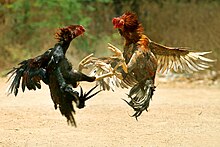
TheSupreme Court of Indiahas banned cockfighting as a violation of thePrevention of Cruelty to Animals Act,but it remains popular, especially in the rural coast ofAndhra Pradesh,with large amount of betting involved, especially around the festival ofSankranti.[65][66][67]
Indonesia[edit]
All forms of gambling, including the gambling within secular cockfighting, were made illegal in 1981 by the Indonesian government, while the religious aspects of cockfighting within Balinese Hinduism remain protected. However, secular cockfighting remains widely popular in Bali, despite its illegal status.[68]
Iraq[edit]
Cockfighting is illegal but widespread in Iraq. The attendees come to gamble or just for the entertainment. A rooster can cost up to $8,000, or ₹23,000.00. The most-prized birds are called Harati, which means that they are of Turkish or Indian origin, and have muscular legs and necks.[69]
Japan[edit]
Cockfighting was introduced to Japan from China in the early 8th century and rose to popularity in theKamakura periodand theEdo period.[70]Cockfighting endured in some Japanese regions even after being banned in 1873,[70]during theMeiji period.[71]
Malaysia[edit]
Animal fighting and baiting are prohibited under the Animal Welfare Act (2015).[72]
Mexico[edit]
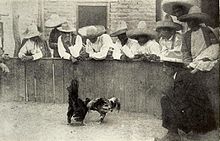
There are cockfight bans in the country's capital,Mexico City,[73]and in the states ofSonoraandCoahuilasince September 11, 2012, and inVeracruzsince November 6, 2018.[74]
Cockfighting is tolerated in theMexican statesofMichoacán,Aguascalientes,Jalisco,Sinaloa,andVeracruz,mostly during regional fairs and other celebrations. Cockfights are performed inpalenques(pits).[75]Cockfighting remains legal in the municipality ofIxmiquilpanand throughout Mexico.[76]
The two parties to the bird fights are traditionally distinguished by red and green, typically by wearing ascarfor badge hanging on the belt. Cockfighting may be combined with a musical show. Fairs and regional festivals of the country's municipalities are held in venues called "palenques" of roosters. These consist of a ring made of wood whose center is full of compacted earth for the best 'performance' of the roosters. In the center, a box 4 meters per side and lines that cross from center to center each side are marked withlime.Finally, the last square, measuring 40 cm on each side, is marked in the center of the arena, where the roosters are taken the third time they are released.
Netherlands[edit]
In the Netherlands, organising or attending cockfights is illegal and punishable by up to three years imprisonment, or a fine of up to 20,500 euros.[77]
New Zealand[edit]
The act of cockfighting is illegal under theAnimal Welfare Act 1999,as is the possession, training and breeding of cocks for fighting.[78]
Pakistan[edit]
Cockfighting was a popular sport in rural Pakistan; however, "betting is illegal under the Prevention of Gambling Act 1977".[79]Betting is illegal, but police often turn a blind eye towards it.[citation needed][80]InSindh,people are fond of keeping fighting cock breed, known asSindhi aseelin Pakistan. These cocks are noted being tall, heavy and good at fighting. Another popular breed is calledMianwaliAseel. InSindhGamblor or KhaftiusesAlmondand other power enhancing medicines to feed the fighter cocks.[citation needed]
Panama[edit]
Law 308 on the Protection of Animals was approved by theNational Assembly of Panamaon 15 March 2012. Article 7 of the law states: 'Dog fights, animal races, bullfights – whether of the Spanish or Portuguese style – the breeding, entry, permanence and operation in the national territory of all kinds of circus or circus show that uses trained animals of any species, are prohibited.' However, horse racing and cockfighting were exempt from the ban.[81]
Paraguay[edit]
Organising fights between all animals, both in public and private, is prohibited in Paraguay under Law No. 4840 on Animal Protection and Welfare, promulgated on 28 January 2013. Specifically:
- 'The use of animals in shows, fights, popular festivals and other activities that imply cruelty or mistreatment, that can cause death, suffering or make them the object of unnatural and unworthy treatments' is prohibited (Article 30).
- 'Training domestic animals to carry out provoked fights, with the goal of holding a public or private show' is considered an 'act of mistreatment'. (Article 31)
- 'The use of animals in shows, fights, popular festivals, and other activities that imply cruelty or mistreatment, which may cause death, suffering or make them subject to unnatural or humiliating treatment' is considered a 'very serious infraction' (Article 32), which are punishable by between 501 and 1500 minimum daily wages (jornales mínimos,Article 39), and the perpetrator may be barred from 'acquiring or possessing other animals for a period that may be up to 10 years' (Article 38).[82]
Peru[edit]
According to theEncyclopedia of Latino Culture,Peru "has probably the longest historical tradition" with cockfighting, with the practice possibly dating back to the 16th century.[75]Cockfighting is legal and regulated by the government in Peru. Most pits (coliseos) in the country are located inLima.[75]Cockfighting and bullfighting are exempt from Peru's animal protection laws.[83]
In October 2018, over 5,000 Peruvians signed a petition that called for a constitutional ban on "all cruel shows using animals" including cockfighting and bullfighting, which was accepted and taken into consideration by theSupreme Court of Peru.However, with only three of the five required judges agreeing with the petition, on 25 February 2020 the Court ruled that it could not declare the animal fighting practices unconstitutional, leaving the applicants with no further option of appeal. A week before the verdict, thousands of other people had marched through the streets of Lima in support of the animal fighting practices.[83]
Philippines[edit]

There is no nationwide ban of cockfighting in the Philippines but since 1948, cockfighting is prohibited everyRizal Dayon December 30 where violators can be fined or imprisoned due to the Republic Act No. 229.[84]It further is supplemented by Presidential Decree No. 449 or the Anti-Cockfighting Law of 1974 which allows cockfights only on Sundays, certain holidays, and on certain other occasions, and only at licensed cockpits.[85]
On March 14, 2020, theDepartment of the Interior and Local Government(DILG) announced that cockfighting is temporarily banned in the Philippines due to the prohibition of mass gatherings amid thecoronavirus pandemicandcommunity quarantinesacross the Philippines.[86][87]
Davao CityMayorSara Dutertebanned cockfighting inDavao Citysince April 16, 2020, also due to the coronavirus pandemic.[88]
The Philippines have a very deep cultural root connected to cockfighting that goes back to ancient times. It can be said that the Filipinos brought a major wave of cockfighting over to Hawaii when the Filipinos first arrived, even though it was widely condemned by locals of the area.[89]
The popularity of cockfighting in the Philippines has extended into the digital space, with the advent of online sabong or e-sabong. This virtual iteration allows enthusiasts to participate in and bet on cockfights via internet streaming. The surge in online cockfighting has been significantly facilitated by the integration of modern technologies, particularly through online casino platforms that host these events. Payment apps like GCash have also played a crucial role, offering a convenient and secure method for placing bets and managing transactions online.[90]
Poland[edit]
Cockfighting in Poland is banned. The law bans any animal cruelty in general, there are no specific laws for cockfighting. Likewise in many other European countries, this activity used to be popular up to the 18th century. In theSilesiaarea it used to be popular longer, even in the 19th century. It was usually held on the Day ofSaint Gall(16 October).[91]This activity was banned on most of the territory of Poland after thePartitions of Polandand before the country regained its independence in 1918. In western areas that were held by Germany, it was banned in 1871 by § 360 p. 13 of the Penal Code of the German Reich. In eastern areas that were held by Russia, it was banned in 1903 by § 287 of the Penal Code of Tagancev Nikolaj Stepanovič. After regaining independence these laws were still in power until new laws were passed. The first animal-cruelty law in independent Poland was passed in 1928 as a presidential decree[92]and it was in power until 1997. It was added to the official Penalty Code in 1997 by § 35 points 1–2 in chapter 11. Currently, the penalty for the act is up to 3 years in prison or it might be up to 5 years if the cruelty is more drastic.[93]
Romania[edit]
Cockfights are illegal in Romania under article 25.3 lit. c) of the Law 205/2004, with punishments ranging from 2 to 7 years imprisonment.[94]
Spain[edit]
Cockfighting is banned in Spain except in twoSpanish regions:theCanary IslandsandAndalusia.In Andalusia, however, the activity has virtually disappeared, surviving only within a program to maintain the fighting breed "combatiente español" coordinated by theUniversity of Córdoba.[95]Spain's Animal Protection Law of 1991 recognizes an exception for these regions based on cultural heritage and a history of cockfighting in the region.[96][75]Animal rights organizations have sought to ban the bloodsport nationwide, but have not been successful in advancing legislation through theSpanish Parliament.[96]
Timor-Leste[edit]
Cockfighting and cockfighting betting is legal on licensed venues.[97]
Ukraine
In Ukraine, cockfights, as well as fights involving other animals (dogs, geese, etc.) are prohibited by Art. 25 of the Law of Ukraine "On the Protection of Animals from Cruelty" and Art. 299 of the Criminal Code of Ukraine. For organizing cockfights, the culprit can be sentenced to a fine of up to 850 hryvnias (ukrainan currency) or imprisonment for up to six months.
United Kingdom[edit]
Cockfighting was banned outright in England and Wales and in theBritish Overseas Territorieswith theCruelty to Animals Act 1835.Sixty years later, in 1895, cockfighting was also banned in Scotland, where it had been relatively common in the 18th century.[98]Areconstructed cockpit from Denbighin North Wales may be found atSt Fagans National History MuseuminCardiff[99]and a reference exists in 1774 to a cockpit atStanecastlein Scotland.[100]One of the few perfect examples of a cockpit which still exist today can be found onChislehurst common,London.[101]
According to a 2017 report by theRSPCA,cockfighting in England and Wales was at a five-year high.[102]
United States[edit]
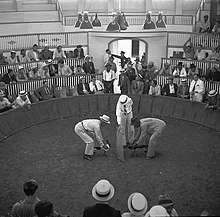
As of 2023[update],cockfighting is illegal in all 50U.S. states,theDistrict of Columbia,and all U.S. territories. The last state to implement astate lawbanning cockfighting wasLouisiana;theLouisiana State Legislaturevoted to approve a ban in June 2007,[103]which went into effect in August 2008.[104]
As of 2013:
- Cockfighting is afelonyin 40 states and the District of Columbia.[105]
- The possession of birds for fighting is prohibited in 39 states and the District of Columbia.[105]
- Being a spectator at a cockfight is prohibited in 43 states and the District of Columbia.[105]
- The possession of cockfighting implements is prohibited in 15 states.[105]
Additionally, the2014 farm bill,signed into law by President Obama, contained a provision making it a federal crime to attend an animal fighting event or bring a child under the age of 16 to an animal fighting event.[106]
The cockfighting ban was further extended by federal law to include U.S. territories—American Samoa, the Northern Mariana Islands, Guam, Puerto Rico, and the U.S. Virgin Islands—effective at the end of 2019, as signed into law in the2018 farm billby President Trump.[107]InPuerto Rico,cockfighting is popular and has been considered a "national sport" since at least the 1950s.[108]According to aNational Park Servicereport, it generates about $100 million annually. There are some 200,000 fighting birds annually on the island. Puerto Rico's Cockfighting Commission regulates 87 clubs, but many non-government sanctioned "underground" cockfighting operations exist.[109]On December 18, 2019, estimating that cockfighting employs 27,000 people and has a value to the economy of about $18 million, Puerto Rico passed a law attempting to keep the practice legal despite the imminent federal ban.[110]In 2021, governorPedro Pierluisiannounced the government would support a legal effort before theU.S. Supreme Courtto overturn the ban.[111]The Supreme Court refused to hear the case,Ortiz-Diaz v. United States,in October 2021, leaving the federal ban in place.[112]
The Animal Fighting Prohibition Enforcement Act, afederal lawthat made it a federal crime to transfer cockfighting implements acrossstate or national bordersand increasing the penalty for violations of federal animal fighting laws to three years in prison, became law in 2007. It passed theHouse of Representatives368–39 and theSenatebyunanimous consentand was signed into law by PresidentGeorge W. Bush.[113]
TheAnimal Welfare Actwas amended again in 2008 when provisions were included in the2008 Farm Bill(P.L. 110–246). These provisions tightened prohibitions on dog and other animal fighting activities, and increased penalties for violations of the act.[114]
Major law enforcement raids against cockfighting occurred in February 2014 inNew York State(when 3,000 birds were seized and nine men were charged with felonyanimal-fightingin "Operation Angry Birds", the state's largest-ever cockfighting bust)[115][116][117]and in May 2017 in California (when theLos Angeles County Sheriff's Departmentseized 7,000 cockfighting birds at a ranch inVal Verde, California,one of the largest cockfighting busts in U.S. history).[118][119]
Vietnam[edit]
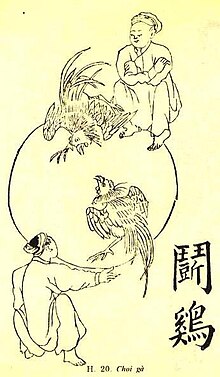
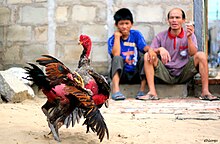
Cockfighting is a popular folk game in Vietnam,[120][121]with a long history dating back to theLý dynasty.[122]According to historical records, the soldiers ofLý Thường Kiệtbrought this game back to Vietnam after conqueringChampa.Initially, cockfighting was only held in rural and mountainous areas, where many ethnic minorities live. However, over time, the game has become increasingly popular throughout the country, from urban to rural areas.
During the feudal era, cockfighting was a popular form of entertainment for the emperor, officials, and the upper class. The emperors often held cockfights during festivals such asTết Nguyên Đán(Vietnamese New Year),Tết Trung Thu,... to entertain their guests. Today, cockfighting is still a popular folk game inVietnam.However, due to the influence of the market economy, cockfighting has become more professional and commercialized.[123][124][125]Large-scale cockfighting arenas,[126][127]chave been built with modern sound and lighting systems, attracting a large number of participants.[128]Cockfighting has also become a sport that is enjoyed by many people, and is often organized in large and small tournaments throughout the country.
Gallery[edit]
-
Cockfight on the outskirts ofKabul,Afghanistan
-
Cockfight inLima,Peru
-
A Philippine gamecock
-
A Philippine "lasak", or off-color fighting cock in teepee, gamecocks cord
-
Cockfight inHilongos,Philippines
-
2024Philippineslegal cockfighting -garden soilarena (gradas), bettors (sabungero), referee (sentensyador-koyme), kristos, confronting cocks at "Meron and Wala" (lyamado-dehado), "bet taker" (promoter, matador-casador) and handlers-( "taga-bitaw" )
-
Confrontinggamefowlsfor "sabong" (fighting)
-
Referee ( "sentensyador-koyme" )
-
Painting of a traditional cockfighting village scene in southernThailand
-
Cockfight inVietnam
See also[edit]
References[edit]
- ^"gamecock".Merriam-Webster.2012-08-31.Retrieved2014-05-10.
First Known Use: 1634
- ^Raymond Hernandez (1995-04-11)."A Blood Sport Gets in the Blood; Fans of Cockfighting Don't Understand Its Outlaw Status".The New York Times.New York City Metropolitan Area.Retrieved2014-05-10.
- ^Jim Bell (February 24, 2011)."East Texas Lawmaker Wants to Outlaw Cockfighting".KSFA 860 AMNewsTalk.RetrievedMay 24,2017.
- ^Sherman, David M. (2002).Tending Animals in the Global Village.Blackwell Publishing. 46.ISBN0-683-18051-7.
- ^Cockfighting.Encyclopædia Britannica 2008
- ^Srinivasan, Doris (1975)."The So-Called Proto-śiva Seal from Mohenjo-Daro: An Iconological Assessment".Archives of Asian Art.29:47–58.ISSN0066-6637.JSTOR20062578.
- ^Iravatham Mahadevan."'Address' Signs of the Indus Script" (PDF).Presented at theWorld Classical Tamil Conference 2010.23–27 June 2010.The Hindu.
- ^abR. D. Crawford (1990).Poultry Breeding and Genetics.Elsevier Health Sciences. pp. 10–11.ISBN9780444885579.OL2207173M.Retrieved2014-05-10.
- ^Al-Nasser, A.; Al-Khalaifa, H.; Al-Saffar, A.; Khalil, F.; Albahouh, M.; Ragheb, G.; Al-Haddad, A.; Mashaly, M. (2007). "Overview of chicken taxonomy and domestication".World's Poultry Science Journal.63(2): 285.doi:10.1017/S004393390700147X.S2CID86734013.
- ^Robert Joe Cutter (1 July 1990)."Fowl Combat".Taiwan Today.Ministry of Foreign Affairs, Republic of China (Taiwan) Dr. Jaushieh Joseph Wu.Retrieved29 August2022.
- ^Robert Joe Cutter (1989).The Brush and the Spur: Chinese Culture and the Cockfight.The Chinese University of Hong Kong Press.ISBN9789622014176.
- ^Curtis, Thomas (19 January 2018)."The London Encyclopaedia: Or, Universal Dictionary of Science, Art, Literature, and Practical Mechanics, Comprising a Popular View of the Present State of Knowledge. Illustrated by Numerous Engravings, a General Atlas, and Appropriate Diagrams".T. Tegg.Retrieved19 January2018– via Google Books.
- ^"Tell en-Nasbeh: Biblical Mizpah of Benjamin".The College of Arts and Sciences, Cornell University.
- ^Miller, James M.; Hayes, John H. (1986).A History of Ancient Israel and Judah.Louisville, Kentucky: John Knox Press. p.422.ISBN978-0-664-21262-9.
- ^Taran, Mikhael (January 1975). "Early Records of the Domestic Fowl in Ancient Judea".Ibis.117(1): 109–110.doi:10.1111/j.1474-919X.1975.tb04192.x.
- ^Borowski, Oded (2003).Daily Life in Biblical Times.Atlanta, Georgia: Society of Biblical Literature. pp. 69–70.ISBN978-1-58983-042-4.
- ^"Ministry International Journal for Pastors – What is new in Biblical Archeology? by Siegfried H. Horn".Ministrymagazine.org.Retrieved2014-05-10.
- ^Moseley, Henry Nottidge (1879).Notes by a Naturalist on the "Challenger".London: Macmillan and Co. p.413.
- ^Staff (2011-02-06)."Cockfighting bird stabs, kills man".The New York Post.Nypost.com.Retrieved2014-02-11.
- ^"Help expose illegal cockfighters".Irish Council Against Bloodsports.RetrievedFebruary 22,2008.
- ^"Death Match".The Scientist.Retrieved19 January2018.
- ^"Animal Protection Group Calls on World Health Organization to Combat Cockfighting as Key Factor in Spread of Avian Flu".Humane Society of the United States. February 18, 2005. Archived fromthe originalon February 19, 2008.RetrievedFebruary 22,2008.
- ^"Using Spirit Worship to Infuse Southeast Asia into the K–16 Classroom".Tun Institute of Learning. January 15, 2005. Archived fromthe originalon December 3, 2012.
- ^ab"Man killed by chicken at illegal cockfight".The Independent.2020-01-22.Retrieved2021-07-12.
- ^"Bali-Cockfighting Tradition Lives".The Jakarta Post.Jakarta, Indonesia: Thejakartapost.com. 2002-01-24. Archived fromthe originalon 2014-02-25.Retrieved2014-02-11.
- ^Bali Today: Love and social life, By Jean Couteau, Jean Couteau et al., pp 128–129, Kepustakaan Populer Gramedia, 2005
- ^Bali, Sekala and Niskala: Essays on society, tradition, and craft, Fred B. Eiseman – page 240 – Periplus Editions, 1990
- ^Bali, Sekala and Niskala, Vol. 2: Essays on Society, Tradition, and Craft, Fred B. Eiseman Jr.
- ^Dundes, Alan (1994).The Cockfight: A Casebook.Univ of Wisconsin Press. p.137.ISBN978-0-299-14054-0.
- ^Logrono, Guam P.; Lagunda, Kevin A. (23 January 2022)."Cebu police collar 30 men for engaging in 'tigbakay' in Carcar, Pinamungajan".Sunstar.Retrieved24 January2022.
- ^Jerry, Mattrew P.; Cheruda, Dominic A. (21 February 2022)."Sabong in the Philippines, E Sabong".SabongHQ.Retrieved8 March2023.
- ^"Emergency: 'Sentensyador'".Gmanews.tv. 2008-07-12. Archived fromthe originalon 2010-04-03.Retrieved2014-02-11.
- ^Peters, Sharon (March 9, 2010)."Authorities crack down on finch-fighting rings".USA Today.Retrieved26 April2017.
- ^"Police bust canary fighting operation".WTNH.July 27, 2009. Archived fromthe originalon August 24, 2011.RetrievedNovember 25,2011.
- ^"Ley 14346 – Malos Tratos y Actos de Crueldad a los Animales"(PDF)(in Spanish).National University of the Littoral.27 November 1954.Retrieved4 June2020.
- ^"Is cock fighting illegal in Australia?".RSPCA Australia knowledgebase.RSPCA Australia-Kb.rspca.org.au. 2009-03-17. Archived fromthe originalon 2014-02-17.Retrieved2014-02-11.
- ^"Dozens charged in major cockfight".2012-09-09.Retrieved19 January2018.
- ^Roel Damiaans (13 January 2020)."Hanengevechten zijn al 153 jaar verboden, maar vallen niet uit te roeien".Het Belang van Limburg(in Dutch).Retrieved4 June2020.
- ^"Overview of Brazil's Legal Structure for Animal Issues – Lane Azevedo Clayton – Animal Legal & Historical Center = Publish Date: 2011".Animallaw.info. Archived fromthe originalon 2013-07-31.Retrieved2014-05-10.
- ^"Brazilian animal law – Alex P".JoinUniverse. 2012-06-19. Archived fromthe originalon 2013-03-13.Retrieved2014-05-10.
- ^"Canada Justice Laws Website".15 November 2019.
- ^"Government of Canada announces measures to strengthen legal protections for children, vulnerable individuals, and animals".
- ^"Ley Núm. 20.380 Sobre Protección de Animales".LeyChile.cl(in Spanish). 3 October 2009.Retrieved5 June2020.
- ^FM, La (2019-03-27)."Corte dice que corridas de toros y peleas de gallos son de arraigo cultural".www.lafm.com.co(in Spanish).Retrieved2019-04-10.
- ^Semana (17 April 2011)."Colombia acoge campeonato de peleas de gallos".Colombia acoge campeonato de peleas de gallos(in Spanish).Retrieved2019-04-10.
- ^"Love and Immolation in Argentina".Washington Post.16 August 1981.
- ^La NacionProhibición de galleras2012. In Spanish
- ^Al DiaArchived2011-08-12 at theWayback Machinein Spanish
- ^Díaz-González, José Andrés; Bastos, Laura Solis.Informe de Encuesta: Percepción sobre aspectos de la coyuntura y las culturas políticas en Costa Rica, 2016(Report).Retrieved19 January2018.
- ^Sequeira, Aarón (2017)."Maltratar a un animal será castigado hasta con 2 años de cárcel; multas serán hasta de ¢212.000".La Nación.Retrieved13 May2017.
- ^Nick Kirkpatrick,Cockfighting has deep roots in Cuba,Washington Post(December 31, 2015).
- ^abSarah Marsh & Alexandre Meneghini,Cockfighting in Cuba: clandestine venues, state arenas,Reuters (April 20, 2017).
- ^abAgustín Pupo Domenech, El Gallo Fino Cubano, 151 pp. Editorial SI-MAR, S.A., La Habana, Cuba 1995 (ISBN9597054051).
- ^Revista Carteles, September 2, 1956.
- ^Reglamento para las lidias de gallos, Ayuntamiento de Holguín, Cuba 1909
- ^"Dominicans beware of US total ban on cockfights".Dominican Today.14 December 2018.Retrieved5 June2020.
- ^Foggo, D.; Campbell, M. (January 22, 2006)."British fans flock to French cockfights".The Times.London.RetrievedFebruary 22,2008.
- ^"Le Guide bu Nord de Pas de Calais"(in French). Region Nord Pas de calais. Archived fromthe originalon February 5, 2008.RetrievedFebruary 22,2008.
- ^abFrench court upholds ban on new cockfighting arenas,France24 (July 31, 2015).
- ^"Strafgesetzbuch für das Deutsche Reich vom 15. Mai 1871 Paragraf 360 Absatz 13"(in German). lexetius.com.Retrieved29 August2022.
- ^"Tierschutzgesetz vom 24. November 1933 §2,3"(in German). Österreichische Nationalbibliothek.Retrieved29 August2022.
- ^"Tierschutzgesetz Ausfertigungsdatum 24.07.1972 §3 Absätze 1b, 7, 8, 8a"(in German). Bundesrepublik Deutschland, Bundesamt für Justiz.Retrieved29 August2022.
- ^Nevins, Debbie (2015).Haiti: Third Edition.New York: Cavendish Square Publishing. p. 110.ISBN9781502608031.Retrieved5 June2020.
- ^"Decreto Nº 115-2015 ─ Ley de Protección y Bienestar Animal"(PDF)(in Spanish). Ecolex. 2016. Archived fromthe original(PDF)on 9 June 2020.Retrieved9 June2020.
- ^"SC puts interim ban on 'cock-fights' sport in AP".Times of India.January 13, 2015.
- ^"This Sankranti, Rs 1,000 cr riding on roosters".Times of India.January 11, 2015.
- ^Srinivasa Rao Apparasu (January 17, 2018)."Banned, but cockfighting spikes in coastal Andhra Pradesh during Sankranti".Hindustan Times.
- ^Cook, William (January 3, 2015)."The Spectator".magazine.RetrievedOctober 24,2016.
- ^"Cockfighting in Iraq: a different kind of battle".Yourmiddleeast.com. 2012-04-11. Archived fromthe originalon 2013-12-13.Retrieved2014-02-11.
- ^abLouis Frédéric,Japan Encyclopedia(trans. Käthe Roth: Harvard University Press, 2002), pp. 132–33.
- ^Frank Stewart & Katsunori Yamazato,Voices from Okinawa: Featuring Three Plays by Jon Shirota(University of Hawaii Press, 2009), p. 56.
- ^World Animal Protection."Malaysia".RetrievedOctober 23,2021.
- ^Prohiben las peleas de gallos y perros en el df pero no las corridas de toros
- ^Prohíbe Coahuila peleas de gallos y de otros animales (Coahuila prohibits fighting of roosters and other animals)
- ^abcdAleksin H. Ortega, "Cockfighting" inEncyclopedia of Latino Culture: From Calaveras to Quinceaneras,Vol. 1 (ed. Charles M. Tatum: Greenwood, 2014), pp. 757–58.
- ^The Tradition of Cockfighting in Mexico,Digg.
- ^"Hanengevechten in Nederland: 'Dit zijn barbaarse praktijken'".RTL Nieuws(in Dutch). 11 December 2018.Retrieved16 May2020.
- ^"Animal Welfare Act 1999".www.legislation.govt.nz.Retrieved31 August2018.
- ^"Cockfight signifies cruel culture – Thursday, 26 July 2012".Pakistantoday.com.pk. 2012-01-09.Retrieved2014-05-10.
- ^United States Department of State (4 August 2011)."Pakistan: Country Reports on Human Rights Practices"(PDF).United States Department of State.Bureau of Democracy, Human Rights, and Labor.Archived(PDF)from the original on 2020-03-20.Retrieved9 September2021.
- ^"Panamá prohíbe las corridas de toros"(in Spanish). Anima Naturalis. 15 March 2012.Retrieved6 June2020.
- ^"Ley Nº 4840 / de Proteccion y Bienestar Animal".Leyes Paraguayas(in Spanish). Biblioteca y Archivo del Congreso de la Nación. 30 January 2013.Retrieved5 June2020.
- ^ab"Cock and bull fighting are legal, Peru's top court rules".Deutsche Welle.26 February 2020.Retrieved4 June2020.
- ^"Banned on Rizal Day: cockfighting, horse-racing and jai-alai".Rappler.28 December 2012.Retrieved21 August2015.
- ^"Bzzzzz: Mandaue cockpit violated PD 449 but law may not cover bettors".ph.news.yahoo.com.Retrieved2022-02-18.
- ^Noreen Jazul (March 16, 2020)."DILG bans cockfighting until April 14".Manila Bulletin.RetrievedApril 27,2020.
- ^"DILG bans local officials traveling overseas amid COVID-19 crisis".ABS-CBN News.March 14, 2020.RetrievedApril 27,2020.
- ^"Davao City bans cockfights, small-town lottery".Rappler.April 17, 2020.RetrievedApril 27,2020.
- ^Anderson, Robert N.; Coller, Richard; Pestano, Rebecca F. (1984),"Cockfighting",Filipinos in Rural Hawaii,University of Hawai'i Press, pp. 151–172,ISBN978-0-8248-0821-1,JSTORj.ctvp7d500.11,retrieved2023-11-03
- ^PH, BetWise (2024-04-15)."Best Online Casinos in the Philippines Accepting GCash 2024".BetWise PH.Retrieved2024-05-07.
- ^Ogrodowska, Barbara (2001).Zwyczaje, obrzędy i tradycje w Polsce.Warsaw: Verbinum. pp. 81–83.ISBN83-7192-128-4.
- ^"Rozporządzenie Prezydenta Rzeczpospolitej z dnia 22 marca 1928 (Polish)"(PDF).
- ^"Chapter 11 of Penalty Code of 1997 (Polish)".
- ^"LEGE (A) 205 26/05/2004 - Portal Legislativ".legislatie.just.ro.Retrieved2024-06-04.
- ^"Peleas de gallo, una actividad legal en Andalucía".canalsur.es(in Spanish).Retrieved2019-03-18.
- ^abOctavio Toledo,Cockfighting ban for Canary Islands fizzles out in Congress,El País(February 16, 2015).
- ^"Decreto-lei № 6/2016 de 20 de abril – Regime Jurídico do Licenciamento, Exploração e Controlo da Atividade dos Jogos Sociais e de Diversão, Máquinas de Jogo e Jogos Tradicionais"(PDF).Jornal da República(in Portuguese).1.Díli: 9214–9226. 2016-04-20.
- ^Collins, T. (2005).Encyclopedia of Traditional British Rural Sports.Routledge.ISBN978-0-415-35224-6.RetrievedDecember 5,2007.
- ^"Cockpit".National Museum Wales.Retrieved15 November2013.
- ^McClure, David (1994).Tolls and Tacksmen.Ayr Arch & Nat Hist Soc. Ayrshire Monograph No. 13. p. 53.
- ^"A history of the Cockpit – Chislehurst Commons".Retrieved2024-04-04.
- ^"Cockfighting".www.express.co.uk.15 August 2017.Retrieved3 September2021.
- ^"Louisiana State House passes Cockfighting ban".Wafb.com. 2014-02-04. Archived fromthe originalon 2009-05-25.Retrieved2014-02-11.
- ^Legisladores de Luisiana aprueban prohibición a pelea de gallosJune 27, 2007La Voz(in Spanish)
- ^abcdFact Sheet: Cockfighting: State Laws,Humane Society of the United States (updated April 2013).
- ^Humane Society Legislative Fund (February 4, 2014)."Farm Bill Strengthens Animal Fighting Law, Maintains State Farm Animal Protection Laws".Humane Society of the United States. Archived fromthe originalon 2014-10-25.
- ^"Public Law 115-334 – Agriculture Improvement Act of 2018",GOVinfo,5 March 2021.
- ^"Cock-fighting in Puerto Rico".Townsville Daily Bulletin (Qld.: 1907–1954).4 May 1953.Retrieved29 October2019.
- ^Meredith Hoffman,Cockfighting is Puerto Rico's Most Resilient Industry,Vice (February 16, 2016).
- ^Sanchez, Ray (December 19, 2019)."Puerto Rico defies US cockfighting ban; court ban likely".CNN.RetrievedDecember 19,2019.
- ^"Gobierno se une como amigo de la corte en el caso sobre las peleas de gallos"[Government will join as friend of the court in cockfighting case].El Vocero(in Spanish). 12 July 2021.Archivedfrom the original on 2021-07-12.Retrieved2021-07-12.
- ^"Supreme Court leaves in place Puerto Rico cockfighting ban".Associated Press.October 12, 2021.Retrieved25 August2022.
- ^"H.R. 137: Animal Fighting Prohibition Enforcement Act of 2007".GovTrack.us.RetrievedFebruary 22,2008.
- ^"Archived copy"(PDF).Archived fromthe original(PDF)on 2013-04-26.Retrieved2012-10-04.
{{cite web}}:CS1 maint: archived copy as title (link)The Animal Welfare Act: Background and Selected Legislation by Tadlock Cowan – Analyst in Natural Resources and Rural Development – September 9, 2010 - ^Antenucci, Antonio (10 February 2014)."70 arrested in NY's largest cockfighting bust".New York Post.Retrieved10 February2014.
- ^Assefa, Haimy (10 February 2014)."New York cockfighting bust uncovers 3,000 birds and yields 9 arrests".CNN.Retrieved10 February2014.
- ^"NY AG: 3,000 Birds Rescued in Cockfighting Bust".ABC News.10 February 2014.Retrieved10 February2014.
- ^Hamilton, Matt (May 16, 2017)."7,000 birds seized in largest cockfighting bust in U.S. history, L.A. County authorities say".Los Angeles Times.RetrievedMay 17,2017.
- ^"Cockfighting Bust in LA County Town Nets 7,000 Birds".NBC Los Angeles. May 16, 2017.RetrievedMay 17,2017.
- ^cand.com.vn."Một thú vui dân gian cần được giữ gìn".Báo Công an Nhân dân điện tử(in Vietnamese).Retrieved2023-11-21.
- ^"Chọi gà – nét đẹp văn hóa truyền thống".beta.baonamdinh.vn(in Vietnamese).Retrieved2023-11-21.
- ^ONLINE, TUOI TRE (2014-09-17)."Chiêu" độc "của giới chọi gà".TUOI TRE ONLINE(in Vietnamese).Retrieved2023-11-21.
- ^"Bị phát hiện khi đang đá gà ăn tiền, quay ra đánh trưởng công an xã".CTV Văn Vũ/VOV.VN.2022-03-22.Retrieved2023-11-21.
- ^thanhnien.vn (2023-08-27)."Triệt xóa tụ điểm đá gà qua mạng tại quán cà phê, bắt giữ 18 người".thanhnien.vn(in Vietnamese).Retrieved2023-11-21.
- ^danviet.vn (6 August 2023)."Công an Phú Thọ: Bắt giữ 50 đối tượng đánh bạc dưới hình thức đá gà, mở sới gà nơi" cực dị "".danviet.vn(in Vietnamese).Retrieved2023-11-21.
- ^"Bình Dương triệt xóa tụ điểm đá gà quy mô lớn".Báo Nhân Dân điện tử(in Vietnamese). 2023-08-02.Retrieved2023-11-21.
- ^VTV, BAO DIEN TU (2023-08-02)."Triệt xóa sới gà có tiền cược lên đến 300 triệu đồng".BAO DIEN TU VTV(in Vietnamese).Retrieved2023-11-21.
- ^VCCorp.vn (14 March 2022)."Chọi gà tỷ đô ở một quốc gia Đông Nam Á: Trò tiêu khiển lâu đời có doanh thu 'ăn đứt' mọi sòng bạc lớn, nhân viên lương tháng 60.000 USD".cafef(in Vietnamese).Retrieved2023-11-21.





